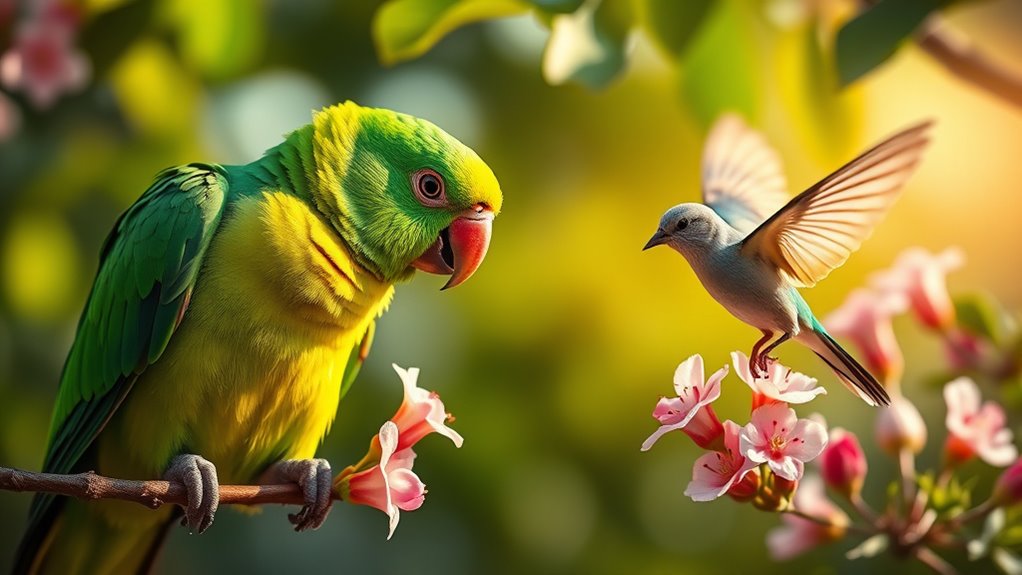Parrots and songbirds learn sounds through a fascinating process. Young birds listen to adult songs during a essential phase of their development, much like kids learning language. They start off babbling and experimenting with sounds, refining their vocalizations over time. Unique neural pathways support this vocal learning, connecting their abilities to human language centers. This remarkable skill isn’t just about imitation; it’s also indispensable for social bonding. Discover more about the intricate world of vocal communication and its significance.
Key Takeaways
- Vocal learning in parrots and songbirds involves active imitation of sounds from their environment and adult birds.
- Young birds undergo a silent listening phase to internalize sounds before they practice vocalizations.
- The development of bird song includes phases like subsong or babbling, allowing for experimentation with sounds.
- Neural mechanisms in birds, similar to human language centers, support auditory processing and sound production.
- Vocalizations facilitate social bonding, mate attraction, and territory defense, highlighting their importance in communication.

Have you ever wondered how some animals can mimic sounds and even learn to communicate in ways that resemble human speech? Vocal learning is a fascinating ability primarily observed in certain birds, like parrots and songbirds. These creatures don’t just produce random sounds; they actively learn and adapt their vocalizations, which can include imitating human speech, environmental noises, or other bird calls. Understanding this phenomenon reveals a lot about their cognitive abilities and the intricate neural mechanisms at play.
Bird song development begins early in a young bird’s life. When these fledglings hatch, they’re typically exposed to the songs of adult birds. This exposure is essential as it sets the groundwork for their own vocalizations. You might notice that young birds often go through a period of silent listening before they start practicing their songs. This stage is vital for them to internalize the sounds they hear, much like how you might learn a new language by listening before you try speaking.
Young birds begin their vocal journey by listening intently to adult songs, laying the foundation for their own unique melodies.
As they grow, these young birds enter a phase called subsong, where they experiment with their vocalizations. You could think of this as a bird’s version of babbling. During this time, they refine their sounds, gradually shaping them into the complex songs associated with their species. The neural mechanisms involved in this process are quite sophisticated. Scientists have identified specific brain regions, like the song control system, that play pivotal roles in vocal learning. These areas facilitate the auditory processing and motor control necessary for producing and mimicking sounds.
What’s truly remarkable is how similar these neural mechanisms are to those found in humans. Just as you use particular brain regions to learn and produce language, birds engage comparable pathways for their vocalizations. Research suggests that both species employ similar strategies for learning through imitation, highlighting the evolutionary significance of vocal communication.
As you explore the world of vocal learning, you’ll likely find that it isn’t just about mimicking sounds; it’s about social interaction and bonding. For many bird species, song serves as a crucial tool for attracting mates and establishing territory. It’s a dynamic process that underscores the importance of communication in the animal kingdom.
Frequently Asked Questions
Do All Birds Possess Vocal Learning Abilities?
Not all birds possess vocal learning abilities. While some species show impressive vocal plasticity, like parrots and songbirds, others lack this skill. Genetic predispositions play a significant role in determining a bird’s capacity to learn sounds. If you observe various bird species, you’ll notice that those with strong vocal learning traits often adapt their calls based on their environment, while others stick to innate sounds, highlighting the diversity in avian communication.
How Do Environmental Factors Influence Vocal Learning?
Environmental factors shape vocal learning like a sculptor chisels a masterpiece. Your habitat impacts the sounds you hear and mimic, while your social environment plays a pivotal role. If you’re surrounded by diverse calls, you’ll likely expand your repertoire. Conversely, a limited social setting might stifle your vocal development. By interacting with others, you absorb and adapt new sounds, enhancing your ability to communicate effectively within your ecosystem.
Can Vocal Learning Occur in Other Animal Species?
Yes, vocal learning can occur in other animal species. You’ll find that some mammals, like dolphins and elephants, also exhibit cultural transmission through unique vocal dialects. This ability allows them to adapt their sounds based on social interactions and environmental influences. By observing their peers, they learn specific calls, enhancing communication within their groups. So, it’s clear that vocal learning isn’t limited to just birds; it’s a fascinating trait across various species!
What Role Does Imitation Play in Vocal Learning?
Imitation plays a vital role in vocal learning by enabling you to mimic sounds and refine your vocalizations. Through mimicry development, you observe and replicate the sounds around you, honing your ability to communicate. This process activates specific neural mechanisms in your brain, allowing you to process and reproduce complex sounds. By engaging in imitation, you not only learn but also adapt your vocal skills to fit your social environment, enhancing your interactions.
How Does Age Affect Vocal Learning in Birds?
Age substantially affects vocal learning in birds. During critical periods, usually early in life, birds are more receptive to sounds and imitation, shaping their future vocalizations. As they progress through developmental stages, their ability to learn new sounds diminishes. Younger birds can absorb and replicate complex calls more easily, while older birds may struggle to adapt. So, if you observe birds at different ages, you’ll notice these distinct vocal learning capabilities.
Conclusion
In the world of vocal learning, parrots and songbirds are like musicians in a grand symphony, each note echoing their unique stories. By mimicking sounds from their environment, they weave intricate tapestries of communication. This remarkable ability not only showcases their intelligence but also deepens our understanding of how learning shapes behavior across species. As we continue to explore these avian artists, we uncover the harmonious connections that unite us all through the language of sound.










